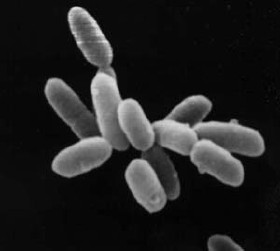A halophile is an extremophile that thrives in high salt concentrations. In chemical terms, halophile refers to a Lewis acidic species that has some ability to extract halides from other chemical species.

Mycobacterium is a genus of over 190 species in the phylum Actinomycetota, assigned its own family, Mycobacteriaceae. This genus includes pathogens known to cause serious diseases in mammals, including tuberculosis and leprosy in humans. The Greek prefix myco- means 'fungus', alluding to this genus' mold-like colony surfaces. Since this genus has cell walls with a waxy lipid-rich outer layer that contains high concentrations of mycolic acid, acid-fast staining is used to emphasize their resistance to acids, compared to other cell types.

Halobacterium is a genus in the family Halobacteriaceae.
The International Code of Nomenclature of Prokaryotes (ICNP) or Prokaryotic Code, formerly the International Code of Nomenclature of Bacteria (ICNB) or Bacteriological Code (BC), governs the scientific names for Bacteria and Archaea. It denotes the rules for naming taxa of bacteria, according to their relative rank. As such it is one of the nomenclature codes of biology.

Haloarchaea are a class of the Euryarchaeota, found in water saturated or nearly saturated with salt. Halobacteria are now recognized as archaea rather than bacteria and are one of the largest groups. The name 'halobacteria' was assigned to this group of organisms before the existence of the domain Archaea was realized, and while valid according to taxonomic rules, should be updated. Halophilic archaea are generally referred to as haloarchaea to distinguish them from halophilic bacteria.

In taxonomy, Haloferax is a genus of the Haloferacaceae.
Halocins are bacteriocins produced by halophilic Archaea and a type of archaeocin.
An archaeosortase is a protein that occurs in the cell membranes of some archaea. Archaeosortases recognize and remove carboxyl-terminal protein sorting signals about 25 amino acids long from secreted proteins. A genome that encodes one archaeosortase may encode over fifty target proteins. The best characterized archaeosortase target is the Haloferax volcanii S-layer glycoprotein, an extensively modified protein with O-linked glycosylations, N-linked glycosylations, and a large prenyl-derived lipid modification toward the C-terminus. Knockout of the archaeosortase A (artA) gene, or permutation of the motif Pro-Gly-Phe (PGF) to Pro-Phe-Gly in the S-layer glycoprotein, blocks attachment of the lipid moiety as well as blocking removal of the PGF-CTERM protein-sorting domain. Thus archaeosortase appears to be a transpeptidase, like sortase, rather than a simple protease.

Haloferax volcanii is a species of organism in the genus Haloferax in the Archaea.
Haloferax larsenii is a gram-negative, aerobic, neutrophilic, extremely halophilic archaeon. It was named in honor of Professor Helge Larsen, who pioneered research on halophiles.

Francisco Juan Martínez Mojica is a Spanish molecular biologist and microbiologist at the University of Alicante in Spain. He is known for his discovery of repetitive, functional DNA sequences in bacteria which he named CRISPR. These were later developed into the first widespread genome editing tool, CRISPR-Cas9.

Haloferacaceae is a family of halophilic, chemoorganotrophic or heterotrophic archaea within the order Haloferacales. The type genus of this family is Haloferax. Its biochemical characteristics are the same as the order Haloferacales.
Haloferax alexandrinus is a species of archaea in the family Haloferacaceae.
Haloferax elongans is a species of archaea in the family Haloferacaceae.
Haloferax gibbonsii is a species of archaea in the family Haloferacaceae.

Haloferax mediterranei is a species of archaea in the family Haloferacaceae.
Haloferax mucosum is a species of archaea in the family Haloferacaceae.
Haloferax prahovense is a species of archaea in the family Haloferacaceae.
Haloferacales is an order of halophilic, chemoorganotrophic or heterotrophic archaea within the class Haloarchaea. The type genus of this order is Haloferax.
Haloferax chudinovii is a species of archaea in the family Haloferacaceae. The species was described in 2013.





